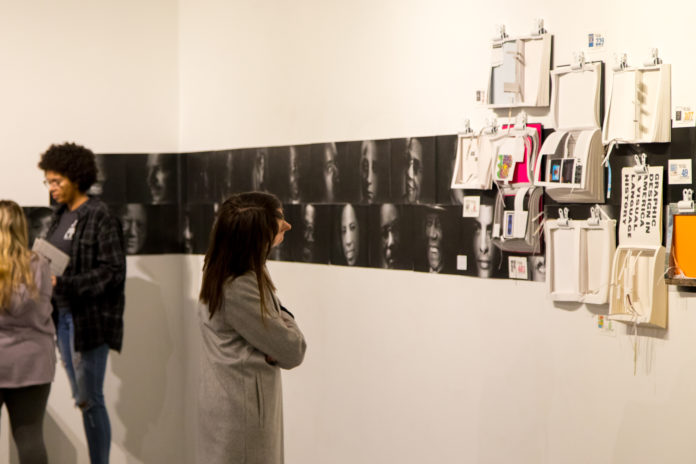As part of Black History Month, the Martha Gault Art Gallery is presenting Pierre Bowins’ “A Sin of Omission,” an exhibition focused on the exclusion of African Americans in graphic design and their lack of representation in history books encompassing the subject.
“[The idea] started when I was going to conferences,” said Bowins, an assistant professor of art at SRU. “You know, no one really looked like me. There were one or two people of color there and that was it.”
Bowins decided to start researching for his graduate program, aiming to look into and uncover any reason for the disparity.
“It’s just who’s publishing whose writing,” Bowins said, pointing out also that there are very few females mentioned in the same books. “Someone told me one time that history is not fact. It’s only somebody’s interpretation of what happened in the past. All of this interpretation is done by Europeans, white males to be more particular.”
One perspective-based piece uses ripples to show different images from two angles. From one standpoint, the faces of both Paul Rand, described as a “modernist master” on his website, and Leroy Winbush, a pioneer in his own right, appear together. Bowins pointed out that the artists have comparable work. However, Rand, who was white, is featured prominently in historical literature, whereas Winbush, an African American, is for the most part overlooked.
The other side showcases a lineage of designers of both skin colors and three artistic movements; Bauhaus, International Modernism and Post Modernism.
“Why are the works of these Black American designers not represented, showcased, or highlighted in design history books or classrooms?” asks Bowins in a detail of his study, provided for opening reception attendees. “Why, instead, have only the works of the Euro-American designers with similar styles been described, presented and featured in said books and classes?”
In a very literal representation of the general absence, Bowins examined eight major design books used in the classroom and used Exacto knives to slash any word not referring African American designers, a process that took three to four months. In the gallery, these books are posted on the wall, the scraps heaped in a pile below.
“A lot of the books don’t have any [black designers] at all,” Bowins said. “And the ones that do have very few. It’s just to show the representation of what’s being taught out there and it’s not an equal balance.”
Bowins also offers an archival collection; including a View-Master restyled by industrial designer Charles Harrison; a Rolling Stone magazine featuring comedian Chris Rock drawn up by Gail Anderson; and postage stamps displaying broken chains, thought of by Georg Olden.
With care, visitors can handle a Black Panther magazine from May 1971 with cotton gloves. Reminiscent of an old-Western wanted poster, the word “MURDERED” jumps off of the yellowing parchment with a headshot of Sam Napier, the publisher and executive editor of the Black Panther National Distribution Office in San Francisco. Inside the paper are multiple reports of members of the Black Panther party being kidnapped. The publication, which AIGA says “reached hundreds of thousands of readers across the United States” was designed by Emory Douglas, who oversaw its art direction and production for roughly 13 years.
“I just want to open the discourse,” Bowins said. “I want more people to talk about it, I want more faculty members to put it in their classroom and just mention it, even though it’s not in the history books.”
The exhibition, located in the Maltby Building, runs through February 27.








